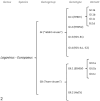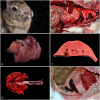Rabbit hemorrhagic disease virus 2, 2010-2023: a review of global detections and affected species
- PMID: 39344909
- PMCID: PMC11457751
- DOI: 10.1177/10406387241260281
Rabbit hemorrhagic disease virus 2, 2010-2023: a review of global detections and affected species
Abstract
Rabbit hemorrhagic disease virus 2/genotype GI.2 (RHDV2/GI.2; Caliciviridae, Lagovirus) causes a highly contagious disease with hepatic necrosis and disseminated intravascular coagulation in several Leporidae species. RHDV2 was first detected in European rabbits (Oryctolagus cuniculus) in France in 2010 and has since spread widely. We gather here data on viral detections reported in various countries and affected species, and discuss pathology, genetic differences, and novel diagnostic aspects. RHDV2 has been detected almost globally, with cases reported in Europe, Africa, Oceania, Asia, and North America as of 2023. Since 2020, large scale outbreaks have occurred in the United States and Mexico and, at the same time, cases have been reported for the first time in previously unaffected countries, such as China, Japan, Singapore, and South Africa, among others. Detections have been notified in domestic and wild European rabbits, hares and jackrabbits (Lepus spp.), several species of cottontail and brush rabbits (Sylvilagus spp.), pygmy rabbits (Brachylagus idahoensis), and red rock rabbits (Pronolagus spp.). RHDV2 has also been detected in a few non-lagomorph species. Detection of RHDV2 causing RHD in Sylvilagus spp. and Leporidae species other than those in the genera Oryctolagus and Lepus is very novel. The global spread of this fast-evolving RNA virus into previously unexploited geographic areas increases the likelihood of host range expansion as new species are exposed; animals may also be infected by nonpathogenic caliciviruses that are disseminated by almost all species, and with which genetic recombination may occur.
Keywords: GI.2; Lagovirus europaeus; Sylvilagus; cottontails; hares; jackrabbits; rabbit hemorrhagic disease; rabbit hemorrhagic disease virus 2; rabbits.
Conflict of interest statement
Declaration of conflicting interestsThe authors declared no potential conflicts of interest with respect to the research, authorship, and/or publication of this article.
Figures





References
-
- Abade dos Santos FA. Quadro anatomo-histopatológico e diagnóstico molecular da doença hemorrágica viral em coelho-bravo [Anatomic-histopathologic picture and molecular diagnosis of viral hemorrhagic disease in wild rabbit]. Master thesis. Lisboa, Portugal: University of Lisboa, 2018. Portuguese. https://www.repository.utl.pt/handle/10400.5/15206
-
- Abade dos Santos FA, et al. Leporids’ emerging diseases as a threat to biodiversity. In: Saxena KS, ed. Viral Outbreaks: Global Impact and Newer Horizons. IntechOpen, 2023. doi: 10.5772/intechopen.110028. - DOI
-
- Abade dos Santos FA, et al. Spillover events of rabbit haemorrhagic disease virus 2 (recombinant GI.4P-GI.2) from Lagomorpha to Eurasian badger. Transbound Emerg Dis 2022;69:1030–1045. - PubMed
Publication types
MeSH terms
LinkOut - more resources
Full Text Sources
Miscellaneous

